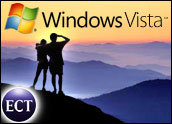
Microsoft on Wednesday released Windows Vista to manufacturing after multiple delays, backlash from security vendors and European Commission wrangling.
The release to manufacturing means that Microsoft has finished development work on the new operating system and is preparing for the final product release. Microsoft’s deep investment in Vista has made it the company’s most heavily tested OS version ever.
Vista will be released to volume license customers on November 30; the consumer version of the OS will hit the street on January 30, 2007.
“Windows Vista is built to be our most reliable operating system yet. We used new development methodologies that helped us build more secure and reliable software and, thanks to the Internet, we’ve distributed prerelease versions of Windows Vista to many more testers than ever before,” said Sven Hallauer, release manager and director of program management at Microsoft.
Improved Feedback Loop
Reliability, usability and security are the earmarks of the new system, Hallauer said.
“We didn’t just fix the bugs. We took a new look at the classic places where customers have had the most pain. For example, we have a much more robust feedback mechanism built into Vista to detect application crashes and hangs. We made a special effort to fix those issues, both through bug fixing and architectural changes,” Hallauer noted.
PC makers, device manufacturers and software developers can now complete work on their Vista-compatible products and applications.
What Defines User-Friendly?
Whereas Apple’s Mac OS is better known for user-friendliness than Windows, Microsoft is boasting usability as a core feature of Vista. Microsoft’s definition of usability, though, covers overall system performance as opposed to ease of use of the user interface and features.
“The quality of Vista looks good. The security looks good. The usability is ok. Microsoft could have done better. There are a lot of features that extend the usability but there is also a lot of additional complexity, too,” JupiterResearch Senior Analyst Joe Wilcox told TechNewsWorld.
Vista’s SuperFetch memory manager is, from Microsoft’s perspective, one of the features that extends usability. SuperFetch ferrets out usage patterns and prepares commonly used data before it’s needed. For example, if a user regularly logs in around 9 a.m. every morning and runs Microsoft Outlook, SuperFetch proactively ensures that Microsoft Outlook is loaded in memory a few minutes prior to 9 a.m.
Steeped in Security
Security is perhaps Vista’s main highlight. It is the first Microsoft operating system designed under the Secure Development Lifecycle (SDL), which is the firm’s process for detecting flaws and correcting code. Microsoft made significant investments in security, focusing in depth on defense while incorporating more traditional code-fuzzing techniques, Hallauer said.
“Even though Vista is a more secure operating system, it’s not impenetrable. There will always be people looking for flaws,” he added. “We’ve worked hard to make their job difficult.”
Microsoft’s Challenge
The computing landscape has changed since Microsoft started work on Vista. For example, some users now look to the Internet — not the Windows desktop — as a primary computing platform. Microsoft’s real challenge is that people will choose to continue running Vista and then enhance that experience via Web-based activities.
“Consumers could use Windows Mail or something like Gmail. They could use Windows Photo Gallery or Flickr. There are many utilities that are now available in a browser that people already use,” Wilcox noted.
“Does that mean Vista is going to flop? No. It’s going to be a success,” he predicted, “because it’s the main choice, and Microsoft has done some good work.”





















































